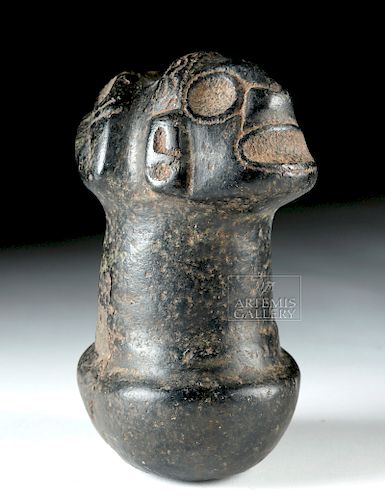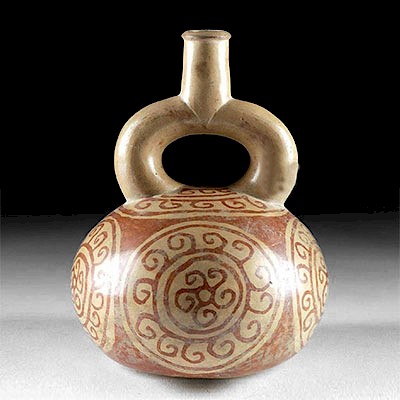Taino Stone Zemi Pestle
Lot 91b
About Seller
Artemis Fine Arts
686 S Taylor Ave, Ste 106
Louisville, CO 80027
United States
Selling antiquities, ancient and ethnographic art online since 1993, Artemis Gallery specializes in Classical Antiquities (Egyptian, Greek, Roman, Near Eastern), Asian, Pre-Columbian, African / Tribal / Oceanographic art. Our extensive inventory includes pottery, stone, metal, wood, glass and textil...Read more
Estimate:
$1,500 - $2,000
Absentee vs Live bid
Two ways to bid:
- Leave a max absentee bid and the platform will bid on your behalf up to your maximum bid during the live auction.
- Bid live during the auction and your bids will be submitted real-time to the auctioneer.
Bid Increments
| Price | Bid Increment |
|---|---|
| $0 | $25 |
| $300 | $50 |
| $1,000 | $100 |
| $2,000 | $250 |
| $5,000 | $500 |
| $10,000 | $1,000 |
| $20,000 | $2,500 |
| $50,000 | $5,000 |
| $100,000 | $10,000 |
| $200,000 | $20,000 |
About Auction
By Artemis Fine Arts
Jan 24, 2019
Set Reminder
2019-01-24 10:00:00
2019-01-24 10:00:00
America/New_York
Bidsquare
Bidsquare : Pre-Columbian / Ethnographic Art
https://www.bidsquare.com/auctions/artemis-gallery/pre-columbian-ethnographic-art-3814
Featuring ancient and ethnographic art from around the world, including Pre-Columbian, Native American, African / Tribal, Ethnographic, Spanish Colonial, Fossils, Fine Art, much more. Artemis Fine Arts info@artemisfinearts.com
Featuring ancient and ethnographic art from around the world, including Pre-Columbian, Native American, African / Tribal, Ethnographic, Spanish Colonial, Fossils, Fine Art, much more. Artemis Fine Arts info@artemisfinearts.com
- Lot Description
Pre-Columbian, Hispaniola, Greater Antilles Islands, Taino/ Arawak Indians, ca. 1000 to 1500 CE. Carved from a rich, dark stone, this pestle presents a Zemi figure's face with his crouched body behind - a very clever composition. Note the meticulously pecked and incised skeletal features of the face - round deep-socketed eyes, prominent nasal cavity, wide open mouth, and double-lobed ears - and behind this visage - the skillfully presented arms, spinal column, and feet of his body. Zemi figures are among the only items specifically referenced by Spanish chroniclers of the 15th century - and this is a very unusual example. The pestle may have been used to create Cohoba powder - a substance traditionally inhaled by a shaman to produce hallucinogenic effects and visions during a ritual that the Tainos interpret as apparitions of spirits who deliver important messages. Size: 6.25" L x 4" H (15.9 cm x 10.2 cm)
Taino art is comprised of many cult objects associated with the worship of "zemis". The term zemi refers to deities, ancestors, or earth spirits. The Zemi (or Cemi) head, with its characteristic three cardinal points, is a fundamental symbol in the Taino religion. Tainos traditionally name the three points "Yocahu Bagua Maorocoti" -- another word for the Creator, Yaya. Zemis like this example are believed to be inhabited by powerful spirits. The uppermost point represents the top of this sacred mountain peak, in the turey (sky) of the four directions, where Yaya - the Creator, whose name means that which has neither beginning nor end and which has no male ancestor or creator - resides. The 'chin' point represents Coabey, the underworld or place of the dead. Here Hupia, the spirit of the dead, resides, and the face of Guayaba, the Chief of Coabey, is represented. Finally, the opposite point represents the land of the living where Goiz, the spirit of living people, resides. A similar three-pointer example is shown in fig. 29a, p. 117 in "The Tainos: Rise and Decline of the People Who Greeted Columbus", (Irving Rouse, 1992).
Provenance: private Southern California, USA collection, acquired in the 1970s to mid-1980s
All items legal to buy/sell under U.S. Statute covering cultural patrimony Code 2600, CHAPTER 14, and are guaranteed to be as described or your money back.
A Certificate of Authenticity will accompany all winning bids.
We ship worldwide and handle all shipping in-house for your convenience.
#141698Expected surface wear with nicks and abraded areas that have smoothed over time. Nice lustrous patina and iron-rich earthen deposits across the surface.Condition
- Shipping Info
-
All shipping is handled in-house for your convenience. Your invoice from Artemis Gallery will include shipping calculation instructions. If in doubt, please inquire BEFORE bidding for estimated shipping costs for individual items.
-
- Buyer's Premium



 EUR
EUR CAD
CAD AUD
AUD GBP
GBP MXN
MXN HKD
HKD CNY
CNY MYR
MYR SEK
SEK SGD
SGD CHF
CHF THB
THB















